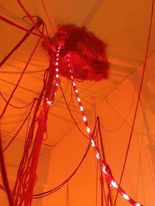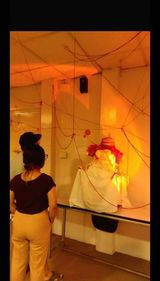The exhibition ‘Photographic Images and Matter, Japanese Prints of the 1970s’ kicks off at the Embassy of Japan
2 years ago

Photo Credit : Sneha Dahal, SJ, Jessica Basnet
KATHMANDU,
“Not all who menstruate are women and not all women menstruate,” says SJ, who identifies them as a non-binary person. Student Ambassadors SJ, Jessica Basnet and Sneha Dahal conducted an art exhibition themed ‘Bloody Mary No More’ at Thames International College, Kathmandu from May 29 to June 1 with the slogan ‘Letsdignifymenstruation' in an effort to address various menstrual experiences among trans-people and raise awareness that cis and trans-menstruators matter and are not different in a challenging society where menstruation is a cis-normative phenomenon. The exhibition is named ‘Bloody Mary No More’ because people assume Mary is a cis woman. The exhibition attempts to discard this assumption of Mary’s gender and sex characteristics.
Worldwide and mainly in South Asian cultures, including Nepal, menstruation is conceived as a woman's issue. But this kind of notion leaves behind other people who don’t identify themselves as women but also menstruate; be it intersex, trans-men, or non-binary people. Talking about the framework of our society in regard to the nature of menstruation, many perceive it to be a strictly female bodily function despite much recognition that menstruators are of various gender identities. The exhibition aimed at making people aware that menstruation should not be a taboo anymore, ‘it shouldn’t be hidden or talked about in metaphor’ (such as that time of the month or code red), and about tackling period stigmatization.
Art and key symbolisms;
Red Yarn → symbolizes the period blood and the thick strand of yarn symbolizes the umbilical cord.

Butterfly → signifies the transformation into womanhood, metaphorically about how having your period means that a young girl is capable of having a child, and is now a woman. The butterflies are embellished through the red yarn into the vagina.
Mirror & person → the gender neutral person's body is covered with the mirror, and only the head is showcased. The identity of a person is represented as anonymous to show that one’s identity comes from one's brain, and not their sexual characteristics. The question raised is: because they bleed and don't identify as a woman, what does it make them?

The White statue (Rajaswala)→ there are no limbs, no head of the statue, only the middle part of the body is placed. This symbolizes the fact that she is immobilized during the period and the restrictions society has imposed upon her. The body is covered with yarns of red wool symbolizing period blood which suggests that she wants to break free but is held captive. “She is a white structure, which signifies purity, and how a woman who is fertile, when bears children, is highly prioritized and then society is disgusted when she is on period.” said Sneha Dahal. She added that the figure was also kept on top of a pedestal, to refer as a devi while in reality she isn't treated that way.
Human sized pad(Mx.Taboo)→ The term Mx. is used in a more gender neutral way than using Mister and Miss. A huge human sized pad symbolizes that there is nothing to be ashamed of while we are experiencing our period and to talk about it. We do not have to talk about it in a hushed tone. “In advertisements, the color of blood is shown blue while the color of blood is red,” said SJ.

Display of pads from different companies with price tag→ it refers to the ‘period poverty’ and that menstruation hygiene products should be easily accessible.It also puts a shade on the heavy taxes imposed on pads by the government. “Hygiene Products are considered as luxury items” SJ added.
Non binary, trans people bleeding;
Non binary, trans men bleed but they don't identify themselves as being women. We should be able to use the fact that ‘people’ bleed more commonly, because it puts those people in a position where they don’t feel inferior and confused. The event proposes to destigmatize periods for all.
There are trans women, who don't bleed, but they aren't any less of a woman, they are whoever they identify themselves as, and not bleeding doesn't make them any less of a woman.
But there are cis women who don't bleed but they are also considered a ‘less’ of women due to these attributes.
The exhibit portrayed that it is important to talk about gender as an irrelevant construct from menstruation because it doesn’t matter what you look like on the outside; you may have a uterus and you might bleed. The organizers tried to delineate their message explicitly about the negative attitudes, and concepts of menstruation and voice against the stigma and taboo within our culture.

- by Republica

- by Pratyencha Koirala

- by Republica

Leave A Comment